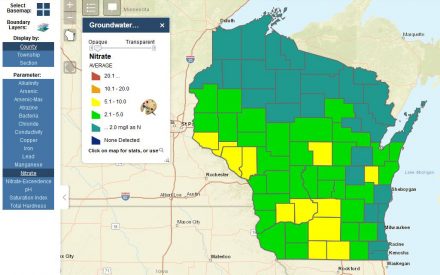Approximately 44% of the population in Wisconsin’s Grant, Iowa, and Lafayette counties relies on private groundwater wells. Collectively, these residents are served by over 18,000 wells. Private wells are not monitored or regulated by federal, state, or local governments; instead, homeowners are responsible for the maintenance and testing of their private well, including any treatment or corrective action to address contamination. Shallow, fractured carbonate rock underlies much of these three counties, and groundwater in this setting is often highly vulnerable to contamination from surface sources. The Wisconsin DNR recently enacted new rules governing manure application over similar areas in eastern Wisconsin, but the rules did not apply to southwest Wisconsin because little research had been done to evaluate groundwater quality in that region. There was a clear need and desire for an evaluation of well-water quality in these three counties.
In response, the Southwest Wisconsin Groundwater and Geology study (SWIGG) was designed to 1) evaluate private well contamination in three counties (Grant, Iowa, and Lafayette) using indicator bacteria (total coliform and E. coli) and nitrate based on randomized synoptic sampling events; 2) assess well construction and geological characteristics (such as well age, depth to bedrock) that affect total coliform and nitrate contamination; and 3) identify the source of contamination in a subset of total coliform- and nitrate-positive wells once per season using microbial tests that distinguish between human, bovine, and swine fecal sources.
In phase one we conducted two samplings over two different three-day periods of randomly selected wells from the three counties (840 wells in all). Those samples were tested for total coliform, E.coli, and dissolved nitrate. Total coliform is a measure of non-pathogenic bacteria commonly found in soil and at the land surface. The presence of total coliform in well water is often an indicator of contamination from surface sources. E.coli is a type of fecal bacteria that can cause illness. Dissolved nitrate (NO3) is a nutrient common in fertilizers and manure and can have human health impacts if present above the drinking water standard of 10 milligrams per liter. In phase two we carried out four rounds of subsampling of wells found to be contaminated in phase one, with the goal of determining the fecal source of the contamination (distinguishing between humans, cattle, or swine). A subsequent phase involves comparing the sample results to hydrogeologic factors such as land use, local geology, and well construction.
Staff at Extension’s Wisconsin Geological and Natural History Survey worked with USGS and USDA scientists as well as with Extension’s county-based staff to carry out the sampling program. The team initially sampled 830 wells and collected 138 follow-up samples. The initial results of the study, released at the beginning of 2019, showed that 42% of the sampled wells in the three counties exceeded drinking water recommendations of either bacteria, nitrate, or both. These results grabbed the attention of local citizens and state regulators, and were in part responsible for Governor Evers’ declaring 2019 the Year of Clean Water in Wisconsin and the establishment of the bipartisan Speaker’s Task Force on water quality. Subsequent sampling rounds of the contaminated wells using sophisticated microbial source tracking have found fecal microbes originating from humans, cattle, or swine in many wells, demonstrating that local land use is contributing to contamination. Some of these microbes, such as salmonella and cryptosporidium are potentially pathogenic to people or animals, and in those cases the well owners were immediately notified.
Our research shows that groundwater contamination by nitrate and bacteria is common in southwest Wisconsin and that sources include humans, cows, and pigs as well as manure and agricultural fertilizers.
The Southwest Wisconsin Groundwater and Geology study is part of Extension’s Natural Resources Institute. Learn more by visiting go.wisc.edu/swigg.
Download Article

 Ensuring Safe Drinking Water for Rural Wisconsin
Ensuring Safe Drinking Water for Rural Wisconsin Youth in Governance
Youth in Governance Photographing Core Samples from the Department of Transportation
Photographing Core Samples from the Department of Transportation Mitigating Manure’s Effect on Water Quality
Mitigating Manure’s Effect on Water Quality


